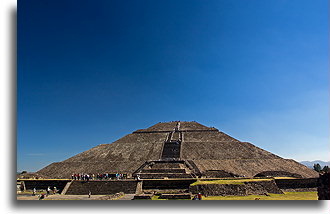
In the highlands of Central Mexico flourished the most significant city in the Western Hemisphere. With its estimated population of at least one hundred thousand, Teotihuacán was the largest in Mesoamerica and one of the largest in the world at that time. The size of this city strikes from the moment you enter the Avenue of the Dead. It is an overwhelming number of structures. Besides great pyramids, there are richly decorated elite dwellings and hundreds of residential buildings for ordinary residents.


The Palace of Tepantitla contains the most famous mural in Teotihuacan, the Paradise of Tlaloc. The mural shows residents daily life. They are singing and playing. Flowing water irrigates soil and allows plants to grow. Between all the figures butterflies are flying. However, this is not the endlessly carefree image of the city at that time. Staring at the details, we can find people with different skin colors, red, yellow, and blue, which could represent the classes of the Teotihuacan society. In one scene, ball players are playing a ritual game with a blue man in the center. Another scene shows people bound together in a line. They probably are led for the sacrificed.


The third largest in Teotihuacan, after piramids of Sun and Moon, is the pyramid of the Feathered Serpent. The slopes of the pyramid decorated are with stone heads of two gods, the Feathered Serpent or Quetzalcoatl and the rain god, or Tlaloc. The circular goggles easily distinguish the latter. In various locations near the pyramid, archeologists discovered over 200 human remains. These are the sacrificial burials, most likely related to of the dedication of the temple during its construction.






